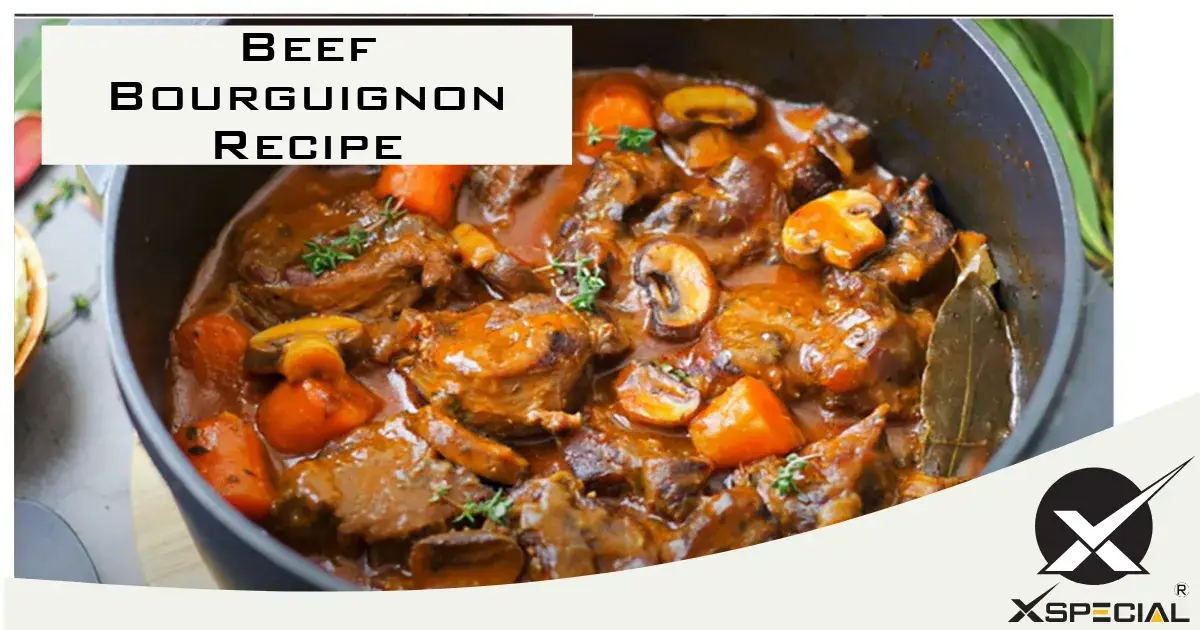When it comes to your health, choosing the right type of beef can make a big difference. You may have heard the terms grass-finished and grain-fed beef, but do you know the differences between them and which is better for you?
Grass-finished beef comes from cattle that have been raised on a natural diet of grass and forage throughout their entire lives. On the other hand, grain-fed meat comes from cattle that are raised in feedlots and fed mostly corn and soy. Understanding the differences between these two types of beef can help you make a more informed decision about what you put on your plate.
Key Takeaways
-
Grass-finished beef is raised on grass and forage throughout the animal’s life.
-
Grain-fed beef comes from cattle raised in feedlots and fed mostly corn and soy.
-
Choosing grass-finished beef can have health benefits, including higher levels of omega-3 fatty acids and antioxidant vitamins.
What is Grass-finished Beef?
Grass-finished beef is a type of beef that comes from cattle that graze on grass and forage throughout their entire lives. This means that the cattle are never fed grains, such as corn or soy, in feedlots, which is a common practice for grain-fed beef.
Grass-finished beef is often considered a healthier and more environmentally friendly option compared to grain-fed beef. Cattle that are grass-finished typically live in pastures or on range land, which allows them to move around and engage in natural behaviors. This also means that they have a lower environmental impact compared to cattle raised in concentrated animal feeding operations (CAFOs).
|
Grass-finished Beef |
Grain-fed Beef |
|---|---|
|
Higher in omega-3 fatty acids |
Higher in omega-6 fatty acids |
|
Higher in antioxidant vitamins |
Lower in antioxidant vitamins |
|
Lower in overall fat content |
Higher in overall fat content |
Grass-finished beef is also often associated with sustainable farming practices. Because the cattle are grazing on grass and forage, they help maintain healthy soil and pasture ecosystems. Additionally, grass-finished beef is often raised without the use of hormones or antibiotics, promoting animal welfare and creating a more natural product.
If you’re looking for high-quality, natural beef that is both healthy for you and sustainable for the environment, grass-finished beef is a great choice. Keep in mind that grass-finished beef may be slightly more expensive than grain-fed beef, but the added nutritional and environmental benefits are worth the extra cost.
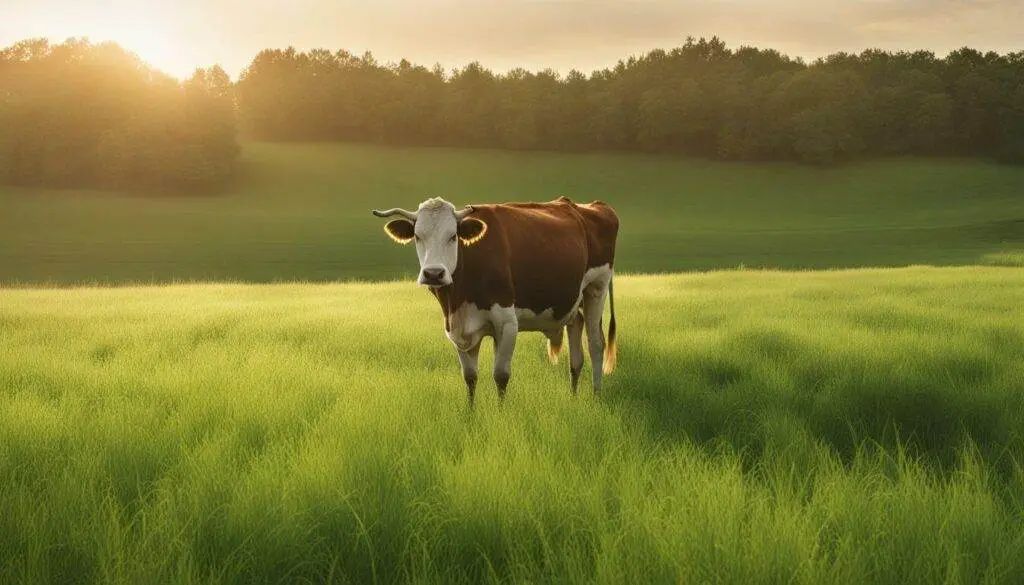
Understanding Grain-fed Beef
If you’ve ever had a steak, chances are it was from a grain-fed cow. Grain-fed beef refers to cattle that are raised in feedlots and fed a diet primarily consisting of corn and soy. This is a departure from their natural diet of grass and forage and has implications for their nutrition and overall quality.
Feeding cattle grains, specifically corn helps speed up the growth process and encourages fat marbling, which is considered desirable for flavor and tenderness. However, this can come at a cost to the nutritional quality of the meat.
Grain-fed beef typically has higher levels of saturated fat and lower levels of healthy omega-3 fatty acids and conjugated linoleic acid (CLA) than grass-finished beef. Additionally, the use of hormones and antibiotics in feedlots can also have negative health implications for both the cows and humans who consume the meat.
While grain-fed beef may be more widely available and less expensive than grass-finished beef, it’s important to consider the impact on both your health and the environment when making food choices.
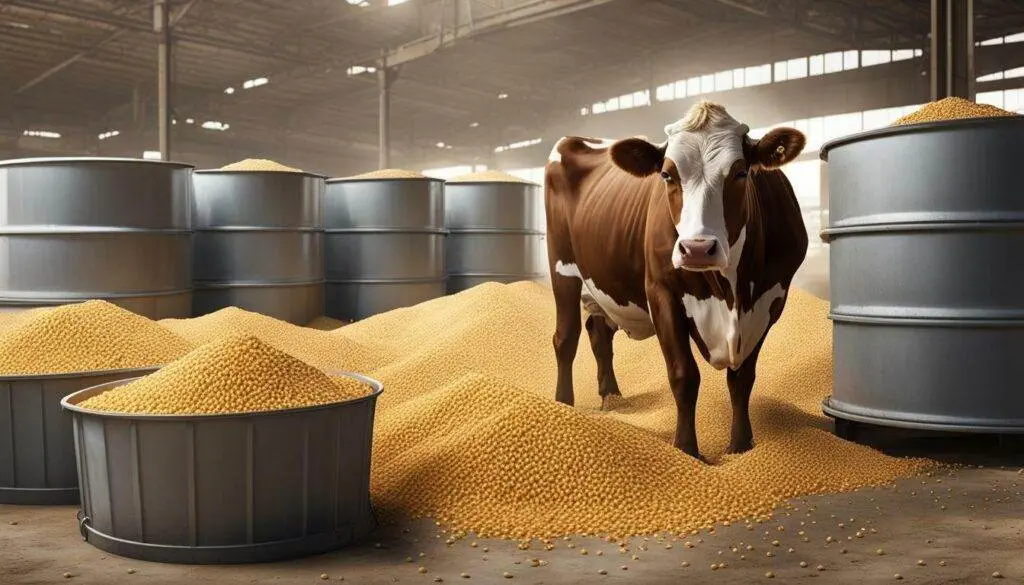
Health Benefits of Grass-finished Beef
Choosing grass-finished beef over grain-fed beef can have significant health benefits. Grass-finished beef is leaner, lower in total fat, and higher in beneficial nutrients than grain-fed beef.
|
Nutrient |
Grass-finished Beef |
Grain-fed Beef |
|---|---|---|
|
Omega-3 Fatty Acids |
2-5 times higher |
Minimal |
|
Conjugated Linoleic Acid (CLA) |
2-3 times higher |
Minimal |
|
Vitamin E |
2-3 times higher |
Minimal |
|
Vitamin A |
5 times higher |
Minimal |
Grass-finished beef is also higher in antioxidants and contains a healthier balance of omega-3 to omega-6 fatty acids, which can help reduce inflammation and lower the risk of chronic diseases such as heart disease and cancer.
Researchers have found that grass-finished beef has better nutrition than grain-fed beef, making it a healthier choice for you and your family.
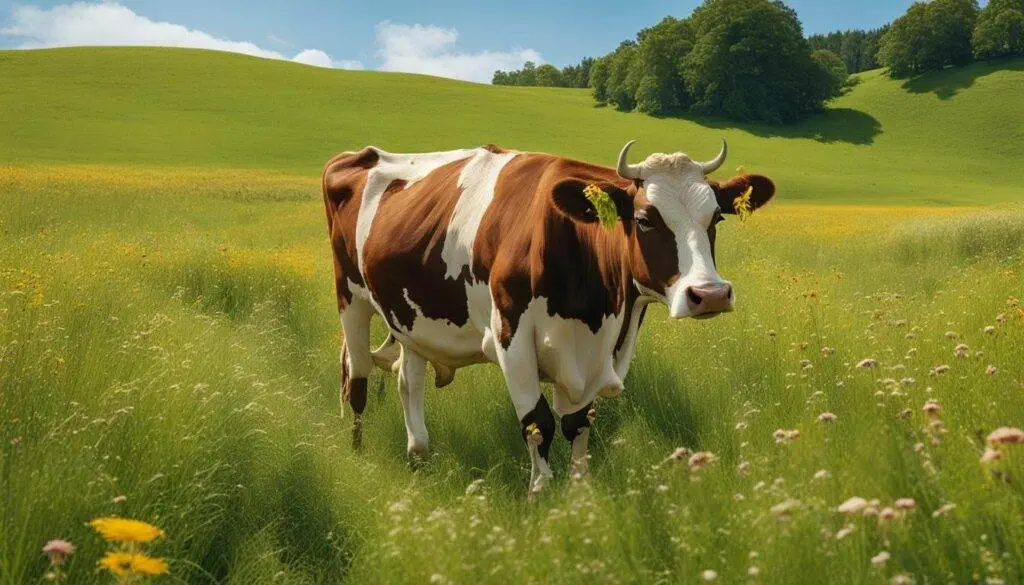
Nutritional Differences Between Grass-finished and Grain-fed Beef
When it comes to nutritional value, grass-finished beef has a different profile than grain-fed beef. Grass-finished beef is leaner, higher in beneficial nutrients, and lower in less favorable ones compared to grain-fed beef.
|
Nutrient |
Grass-finished Beef |
Grain-fed Beef |
|---|---|---|
|
Omega-3 Fatty Acids |
Higher |
Lower |
|
Omega-6 Fatty Acids |
Lower |
Higher |
|
Vitamin E |
Higher |
Lower |
|
CLA (Conjugated Linoleic Acid) |
Higher |
Lower |
|
Antioxidant Vitamins |
Higher |
Lower |
|
Iron |
Lower |
Higher |
The omega-3 to omega-6 ratio in grass-finished beef is more favorable, which can help reduce inflammation in the body. Grass-finished beef is also higher in CLA, a healthy fat linked to reduced inflammation, improved immune function, and lower body fat percentage. Additionally, grass-finished beef is higher in vitamin E and antioxidant vitamins, which can help protect against cellular damage and provide other health benefits.
On the other hand, grain-fed beef typically has higher levels of iron, which can be beneficial for individuals who are iron deficient. However, excessive consumption of iron has been linked to various health problems, so it’s important to strike a balance.
In summary, grass-finished beef has a more favorable nutrient profile compared to grain-fed beef, making it a healthier option for those looking to optimize their diet.

Grass-finished Beef and Sustainable Farming Practices
One of the key benefits of choosing grass-finished beef is its association with sustainable farming practices. Cattle raised for grass-finished beef are often raised on small family farms that practice rotational grazing. This means that the cattle are moved to different pastures to graze on fresh grass, which helps to minimize soil erosion and improve soil health.
Grass-finished beef is also often associated with reduced use of antibiotics and hormones, as grass-fed cattle are generally healthier than grain-fed cattle. Additionally, grass-finished beef production has a lower environmental impact, as there is typically less waste and runoff produced from pastures compared to feedlots.
|
Benefits of Grass-finished Beef and Sustainable Farming Practices |
|---|
|
Rotational grazing: This practice helps to maintain soil health and reduce soil erosion. |
|
Reduced use of antibiotics and hormones: Grass-fed cattle are generally healthier, reducing the need for these measures. |
|
Lower environmental impact: Pasture-raised cattle produce less waste and runoff compared to feedlot-raised cattle. |
Perhaps most importantly, choosing grass-finished beef supports small-scale, local farmers who are committed to sustainable and ethical farming practices. By choosing grass-finished beef, you can play a role in promoting more environmentally friendly and socially responsible farming practices.
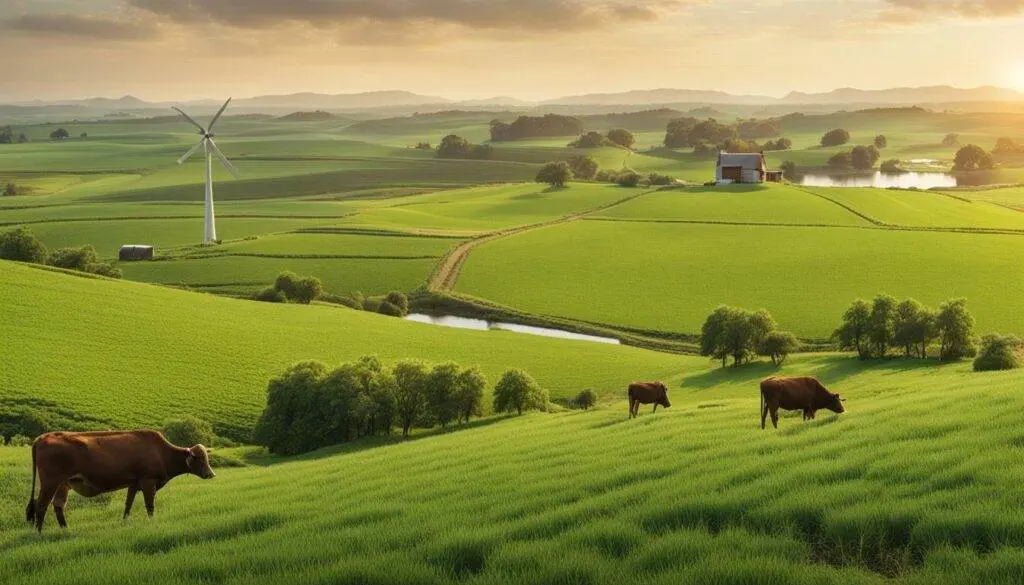
Ethical Considerations of Grass-finished Beef
When it comes to purchasing beef, ethical considerations are increasingly important to consumers, and grass-finished beef is often viewed as a more ethical choice than grain-fed beef.
One ethical consideration is animal welfare. Grass-finished cattle are typically raised in pastures where they have more space to move around and engage in natural behaviors. This can result in less stress and sickness among the animals and may even lead to improved health and meat quality. In contrast, grain-fed cattle are often confined to feedlots, where they may be subject to cramped conditions and limited access to outdoor areas.
Another ethical concern is the use of hormones and antibiotics. Grass-finished beef is often marketed as being free from these additives, as the cattle are raised on a natural, grass-based diet that supports their immune systems and overall health. In contrast, grain-fed cattle may be given hormones and antibiotics to promote weight gain and prevent illness in the crowded feedlot environment.
Additionally, choosing grass-finished beef can be an ethical choice for supporting local farmers and sustainable farming practices. Many grass-finished beef producers prioritize environmental conservation and animal welfare and may use practices such as rotational grazing and reduced chemical use. By supporting these producers, you can help to promote more sustainable and responsible farming practices.
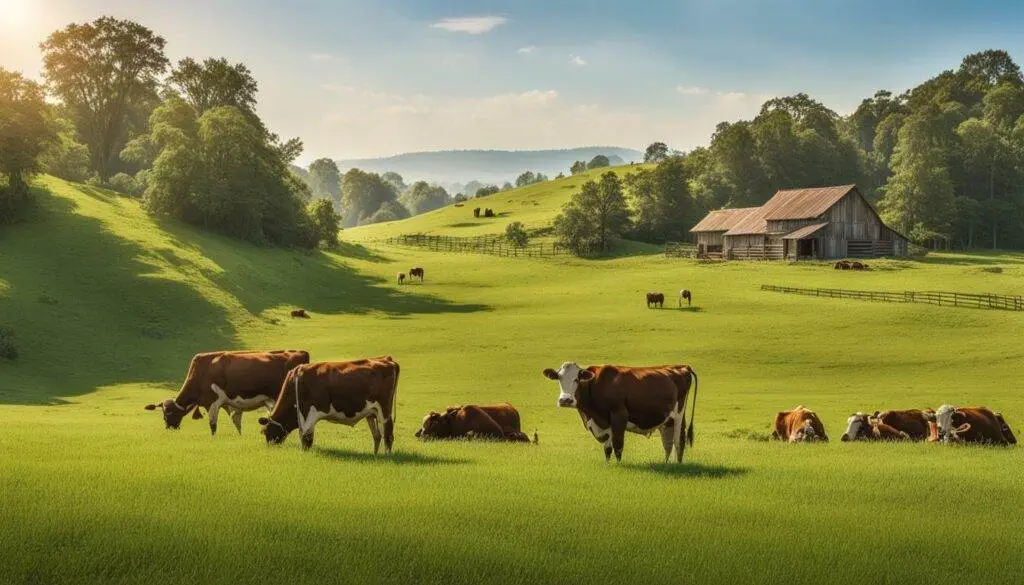
Overall, choosing grass-finished beef can be a more ethical choice for those concerned about animal welfare, environmental impact, and supporting local farmers.
Grass-finished Beef and Quality
Grass-finished beef is often associated with high-quality meat that is natural and flavorful. Grass-fed cattle have a diet that is rich in grass and forage, which promotes better overall health and well-being. As a result, grass-finished beef tends to be leaner, with less marbling and fat content than grain-fed beef.
Additionally, grass-finished beef typically has a higher concentration of nutrients, including vitamin E, beta-carotene, and omega-3 fatty acids. This makes it a healthier option that can improve your overall well-being.
The unique diet of grass-fed cattle also contributes to the taste and texture of the meat. Grass-finished beef tends to be more tender and flavorful, with a rich and beefy taste that is different from grain-fed beef.
“Grass-finished beef is leaner, healthier, and more flavorful than grain-fed beef. It’s a delicious and natural choice for meat lovers who want to enjoy the best quality beef while staying healthy.”
With its unique combination of nutrition, flavor, and quality, grass-finished beef is an excellent choice for anyone who loves meat and wants to eat healthier. Whether you’re grilling up a steak or cooking a roast, grass-finished beef is sure to impress your taste buds and make your meal a success.
So why not try grass-finished beef today? You’ll be glad you did!
Buying Grass-finished Beef
When purchasing grass-finished beef, it’s important to know what to look for in order to ensure you’re getting a high-quality, nutrient-dense product that aligns with your values. Here are some tips:
-
Look for labels: Seek out labels that indicate the beef is grass-finished, pasture-raised, or organic beef. These labels indicate that the cattle were raised on a grass-based diet throughout their lives, with minimal to no use of antibiotics or hormones.
-
Check for certifications: Look for certifications from organizations like the American Grassfed Association or the Global Animal Partnership, which have strict standards for grass-finished beef production.
-
Buy local: Consider purchasing beef from local farmers or farmers’ markets, as this can ensure fresher and more sustainably produced meat.
-
Consider the cost: Grass-finished beef may be more expensive than grain-fed beef due to the higher cost of production, but it’s important to consider the health and environmental benefits when making your purchasing decision.
By choosing grass-finished beef, you’re not only making a healthier choice for yourself, but you’re also supporting sustainable farming practices, local farmers, and ethical treatment of animals. Plus, you’ll enjoy a delicious and high-quality product that’s packed with nutrients.

Conclusion
Congratulations! You have learned about the differences between grass-finished and grain-fed beef. Choosing grass-finished beef over grain-fed beef is a healthy and sustainable choice for you and the planet.
Grass-finished beef is a healthier option, providing higher levels of omega-3 fatty acids, CLA, and antioxidant vitamins. It is also associated with sustainable farming practices, reduced use of antibiotics, and lower environmental impact.
Grass-finished beef is preferred by many due to its higher quality, including tenderness, flavor, marbling, and overall taste. When buying grass-finished beef, look for labels and certification programs, and consider local sourcing to support farmers in your community.
By choosing grass-finished beef, you are supporting animal welfare, avoiding hormones and antibiotics, and promoting environmentally friendly farming practices. It’s time to make the switch and enjoy the delicious, healthy taste of grass-finished beef!
FQAs About Grass-finished And Grain-fed Beef
Q: What is the difference between grass-finished and grain-fed beef?
A: Grass-finished beef is derived from cattle that have been exclusively fed grass throughout their entire lives, while grain-fed beef is sourced from cows that have been primarily fed a diet of grain, such as corn.
Q: Is grass-fed beef healthier than grain-fed beef?
A: Grass-fed beef is generally considered healthier than grain-fed beef. It tends to be higher in beneficial omega-3 fatty acids, lower in unhealthy fats, and contains higher levels of vitamins and minerals.
Q: What are the benefits of grass-fed beef?
A: Grass-fed beef offers several benefits. It is higher in omega-3 fatty acids, which are known for their heart-healthy properties. Grass-fed beef also contains higher levels of conjugated linoleic acid (CLA), a fatty acid that has been linked to potential health benefits such as reduced inflammation and improved immune function.
Q: Does grass-fed beef taste different from grain-fed beef?
A: Grass-fed beef generally has a distinct flavor compared to grain-fed beef. It often has a stronger, earthier taste due to the varied diet of grasses and forage consumed by the cattle.
Q: What is the impact of a grass diet on the quality of beef?
A: The diet of grass-fed cattle can have a significant impact on the quality of beef. Grass-fed beef tends to be leaner and has a more vibrant, natural color compared to grain-fed beef.
Q: Are there any differences in the nutritional composition of grass-fed and grain-fed beef?
A: Yes, there are differences in the nutritional composition of grass-fed and grain-fed beef. Grass-fed beef is typically higher in omega-3 fatty acids, vitamins A and E, and lower in total fat content compared to grain-fed beef.
Q: What are the environmental benefits of grass-fed beef?
A: Grass-fed beef production is generally considered to have fewer environmental impacts compared to grain-fed beef. Grass-fed farming practices rely less on chemical inputs, require less water, and can contribute to soil health and carbon sequestration.
Q: Can grass-fed beef be considered organic beef?
A: Grass-fed beef can be considered organic if it meets the specific organic certification standards outlined by regulatory bodies. These standards address factors such as the use of synthetic chemicals, antibiotics, and the sourcing of feed.
Q: Can grain-fed beef also contain some grass in their diet?
A: Yes, grain-fed beef may contain some grass in their diet, especially if they have access to pasture or are fed a mixed diet that includes grass. However, the primary source of nutrition for grain-fed beef is grains.
Q: What is the difference between grass-fed and grass-finished beef?
A: Grass-fed beef refers to cattle that have been fed grass at some point in their lives, while grass-finished beef specifically refers to cattle that have been exclusively fed grass up until the time of slaughter.



